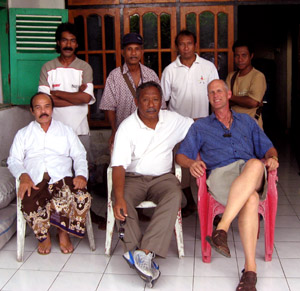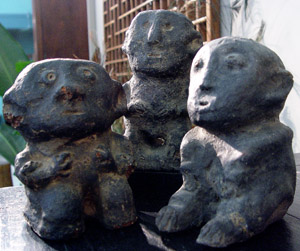There is only one first impression, so I try to focus and pay attention. A strip of a runaway – green, really green everywhere – very soft tropical, humid breeze – that classic touch that many of us travel for. The waiting room at the airport with 6 orange plastic chairs and a bench quickly fills with my fellow passengers. When everyone has found their luggage in these improssibly close quarters, the padlocked exit door is opened and we are all released at once into the parking area. I remember seeing only four cars. There must have been more, somewhere.
Driving through villages, the newer houses are made from local, hand cut stone, mortared together. At first glance, it looks like incredibly bad concrete block work.

Sumba! Images of tribes, villages, and animist culture arise. Well, at this end of the island of Sumba, it is mostly Catholic, with powerful animist overtones. Table-like gravestones carved with traditional motifs and sometimes a small cross, weighing at least 5 tons, dominate every village. We drove 10 minutes on a small village side road to see a large river gushing out of a cave, the source of which is unknown. Daeng, my friend, guide, and the foremost primitive collector in Indonesia, has taken care of everything for us – the car, driver, hotels, itinerary and lots more.
The best hotel in town similar is to many I’ve stayed in in medium sized towns from Yunnan, China to Java. They are roughly the same size, ~ 20′ X 12′, everywhere. There’s a bath in the back right hand corner of the room with a bucket, a cold water tap, a toilet, and one fluorescent bulb. This is rural standard luxury, with AC and a garden courtyard. The cold water bucket bath is a shock to my comfort loving system.

The word is out that Daeng is in town. The small sellers and dealers are waiting outside the rooms, each with 5 to 25 “treasures.” We look at their offerings over late afternoon tea. My tea took an hour to arrive because someone had to go out and buy milk!. I bought several authentic and old pieces at fair prices, of course, with Daeng’s approval. He is the master, mentor and coach. Even more so on his own turf.
I’m in my element now. It is new territory with new sights, sounds, smells and best of all, with a great guide. I’m happy. Once I’m on the ground, sniffing around I’m happy. Just keep me well watered and regularly fed and I’m a happy hound. The poor roads, old cars, late flights with cramped seats, and never knowing what’s next is the uncomfortable (and sometimes painful) reminder of why I’m probably the only white boy within 40 miles. For now, I’m on the ground, pawing, sniffing, prodding, and ultimately bargaining. The prices start high in these parts. I pay 1/4 of the asking price, or a bit less, in the end. The more patient you are and the longer you take to make a deal the better price you will get. I’ve never bargained that way. I’m used to the back and forth, back and forth, deal or no deal style. Tomorrow’s another day and they will be back then to try again at a lower price.
 Each day I found at least a few stunning pieces. I didn’t actually expect to do much buying, since this was billed as a cultural excursion by Daeng. No one speaks much English, so no complicated conversations happen on the whole trip. Lots of joking among our group of four Sumba men happens, but I am accustomed to understanding little of what’s said. So I hang out in “David’s World” looking, thinking, processing what I’ve seen and touched and what’s seen and touched me.
Each day I found at least a few stunning pieces. I didn’t actually expect to do much buying, since this was billed as a cultural excursion by Daeng. No one speaks much English, so no complicated conversations happen on the whole trip. Lots of joking among our group of four Sumba men happens, but I am accustomed to understanding little of what’s said. So I hang out in “David’s World” looking, thinking, processing what I’ve seen and touched and what’s seen and touched me.
Dinner tonight was at Daeng’s brother’s house-cum-machine shop. Tin roof, woven bamboo walls and engine parts everywhere. All three of his brothers were there. It was sweet to be included. The dinner consisted of six or seven dishes, all with meat or fish. Being vegetarian, I ate plain rice. It’s always a hard thing to explain being vegetarian. No one has ever heard of such a thing. I eat plain rice a lot in more remote locations. The blue, green and pink molded plaster chairs are lined up to sit on for dinner. I think they have taken over the world. There must be 2.8 plastic chairs for every man, woman and child in every town in Asia.